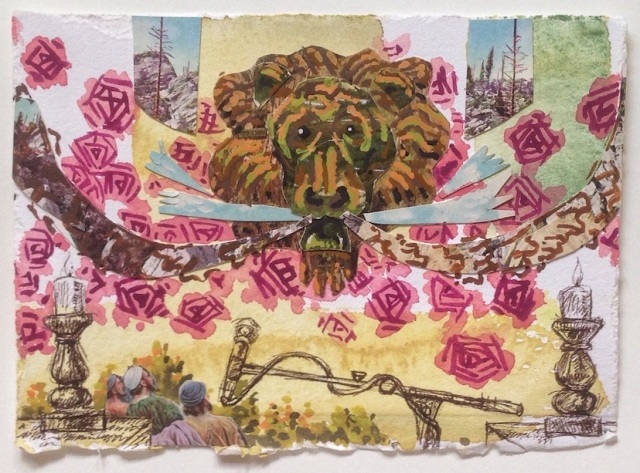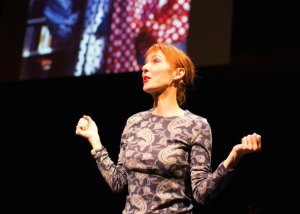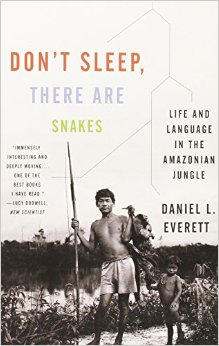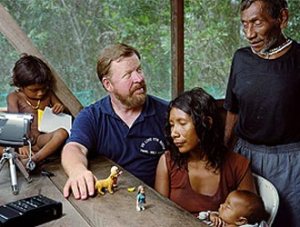
Sad that I’m not at this lovely Irish residency right now…
I’m not supposed to be here. On this very day you should be finding me in Annaghmakerrig, County Monaghan, Ireland. I’m supposed to be at an artist residency at the Tyrone Guthrie Centre tucked in the rolling green of the Midlands just a bit south of Northern Ireland. You would find me in the “sculpture” studio of the residency. That’s the one on the ground floor with windows on two sides. It’s on the end of the apartment wing, clad in grey flat stone work with red bricks framing the white paned glass windows. The studio affords a view of the main house and lake on one side, and the windows on the opposite wall gaze at the glassed in greenhouse reading room and converted farmyard cottages. In the evening, I’d be having dinner at the big community table with all the residents laughing and sharing wine and stories, eating scrumptious dinners and a dessert of pavlova with some amazing seasonal fruit concoction poured over it.
But I’m not there. I’m here, at my home in Newberg, Oregon. If you asked me three months ago, if you asked me a year and a half ago, I would have told you at this very moment of spring I would be listening to the delightful upward lilt of Irish brogues and squinting my ears in deep concentration, deciphering the most extreme of accents and unconsciously mimicking them as the days waxed on. Today I am turning up the volume of my computer so I can hear what someone is saying in a Zoom meeting. Today I am meandering for sixty minutes or so in the neighborhoods of my town, negotiating altering terrains of sidewalk, absolutely no sidewalk, and treacherous paths of tectonic plates of concrete shifted into stumble-enduing obstacle courses, all the while steering into the road or various lawns to keep a six-foot distance from others. If I was at the Tyrone Guthrie Centre in Ireland, I would be walking along the lake far from cars, negotiating a fallen tree branch, moss, and layers of leaves, making an hour or so loop through the countryside perhaps in thoughtful conversation with an artist, writer, musician or poet by my side. We’d comment about the old woods and stone farmhouses built eons ago. Today, I walk by myself past a warren of residential homes built from 1910-2010.
We are all not where we are supposed to be, aren’t we? Or at least we’re not where we thought we’d be. COVID-19 and the shelter in place edict has propelled us into the “Land of Is.” It’s like Oz but not as fancy, and it’s terribly familiar. Things are flying by the window of our house in Kansas, but the mystery we have discovered and landed in is not a technicolor-saturated world of yellow brick and talking scarecrows, but the curious banal land of our kitchen, bedroom, and living room. How do things get so dusty? When was the last time this toilet was cleaned? I need to vacuum, and those windows should be fixed.
Granted, initially I thought I was doing pretty well with all of this, but as time went on, I hit a wall. I am not married; I don’t have my own children. I have spent my relational life investing in college students, nieces, the lives of others, colleagues, dear friends, and healing work and retreats. In my house I have my Scottie dog Lila and a young couple in their early thirties who will be moving out in the next several months into their first home. My relational needs are met almost entirely by investing in the lives of others who are not under my roof, but in the pandemic my avenues of connection have been reduced to screens, ear buds, and texts. This was not the way I, nor anyone was designed to connect. I also love to explore, learn, meet new people and have adventures. I fill the months with life giving opportunities. This could be going to an art residency, an International trip with friends or students, a concert, a play, a workshop, a gathering, or a road trip. These hopeful unique endeavors move me out of my day-to-day life, provide variety, feed my curiosity, and also meet my social needs. Unfortunately, all of those life giving opportunities are off the table right now as well.
Three weeks ago I wanted to go to bed at 8pm and didn’t want to get up the next morning. I confessed to my Latin American Art history students through a computer screen, “The one thing I love most about teaching I’m finding is missing now, and it’s you.” Online connections are certainly something, but they are no substitute for a living breathing sentient being occupying the same space with you. With no “family” living with me, I was missing everyone I was close to. The lack of real connection with those dear to me, and the lack of hope of having such a thing in my house for the long term, took me down like a one-two punch.
I knew I needed to connect in the here and now, so I took care of myself and began calling folks but what was most helpful was when I began to simply get together with a friend to vent and join him regularly as he walked home from work, keeping a six-foot buffer between us. It was sanity-building, and made me aware of my own agency and reminded me not run from this, but to look for ways I can dive into our current climate, to invest in “The Land of Is.”
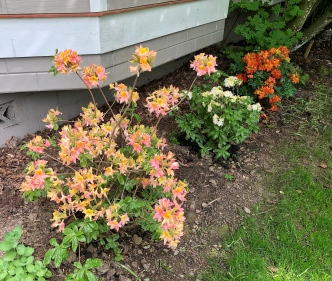 So what is? Initially it was taking time to look at what is around me, like the lovely azaleas that I planted in the fall. When purchasing them the pictures on the tags were so faded that I wasn’t sure what I was paying for, but their descriptions sounded attractive enough. The three plants bloomed sequentially this spring, the first a deep burnt orange fading into gold, the second a pale creamy yellow with hints of pink highlights, the last one to bloom a show off; a lush pink fading into peach. Watching them bloom has been like opening up presents, and I would have never seen the show if I was across the ocean as planned.
So what is? Initially it was taking time to look at what is around me, like the lovely azaleas that I planted in the fall. When purchasing them the pictures on the tags were so faded that I wasn’t sure what I was paying for, but their descriptions sounded attractive enough. The three plants bloomed sequentially this spring, the first a deep burnt orange fading into gold, the second a pale creamy yellow with hints of pink highlights, the last one to bloom a show off; a lush pink fading into peach. Watching them bloom has been like opening up presents, and I would have never seen the show if I was across the ocean as planned.
Another thing in “The Land of Is” is the young couple that lives with me. We have had excellent talks and had more meals together than we ever have had in their almost two years in the house. I also have now seen them teach. They are high school teachers propelled online like I was, with an unexpected urgency. I have seen their late nights creating power points, I have seen them film videos, I have heard them teaching classes live. They are really good teachers. I know this in a way I never would have known if we hadn’t been quarantined under the same roof for months.
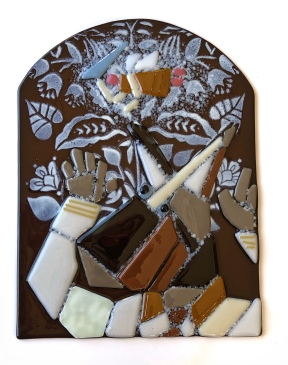
A glass work I made inspired by the story of Balaam from the Old Testament
I also thought “I may not have a studio in Ireland right now, but I have access to a glass studio and kiln that no one is using.” So, I have created for myself a glass workshop of sorts and have been cranking on making kiln-worked artwork. It’s been over ten years since I’ve worked in glass. That would have never happened either.
We have all been confined to the Petri dishes of ourselves in “The Land of Is.” Whatever virus is in here, is certainly growing now. I walk my dog Lila, and often let her run amuck when I’m on campus. A week ago when she ran up to a woman’s dog, the lady bellowed that I needed to control my dog. I immediately got Lila leashed, but the woman raged on. I was initially defensive with her, but after a moment took a different tack, and began apologizing, to no avail. She continued yelling at me as she left. After the encounter I had to sit down in the campus rose garden to decompress for ten minutes. I can’t recall the last time someone yelled at me like that. Maybe she or her dog had been attacked in the past, but her reaction was overwhelmingly disproportionate to the offense. Finding solace in the glow of the roses and warm sun, what came to mind was simple: that lady must be hurting. Maybe she was being yelled at when at home and wanted to yell at someone. Whatever virus she has growing in her sealed COVID-19 Petri dish was clearly thriving. Hurt people hurt. Wounded people wound. It was a reminder for me to keep naming and dealing with my own pain. Don’t pass it on to others; but moreover how do I mitigate the anxiety of others and stop the cycle? At the end of our conversation/yell-fest, how could I have eased her anger? What I did do was apologize a third, and a fourth time, and I sincerely wished that the rest of her Friday went well. She wanted none of it, and yelled over her shoulder “Keep your dog on leash or I’ll call the authorities!” I can only do what I can do.
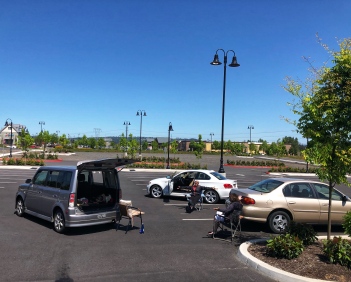
Lunch with friends.
And what I can do in “The Land of Is” is smile under the mask I wear to the grocery store and hope people can tell. I can aim to ease others’ stress and anxiety with courtesy. If they can hear it, I can say a kind word. I can relish an hour or two-hour daily walk with the dog. I can encourage others and reach out to friends. I can try new recipes and learn something in the kitchen. I can have a delightful meal of to-go pizza with friends sitting outside our cars on lawn chairs in an empty bowling alley parking lot, or sit in a back yard with friends with glasses of wine and laugh uproariously when one of our plastic lawn chairs collapses, propelling its occupant backwards to the ground. I can give the yard, house, and artwork my undivided attention. I spent eight hours last Saturday simply loving on the yard, making the planter beds sing. And every Monday afternoon I am working through years of paperwork piled up that I’ve avoided. Tuesday afternoons I’m cleaning the house, and I’m in the studio making art every Monday, Wednesday, and Friday morning.
There will be another time to enjoy Ireland, and being away has helped me appreciate the gift of travel even more. Each day when I start to find myself getting discouraged, I look around and see “what is” and what I can do in the here and now to take care of myself. If it is connection I need, I get on the phone and call several friends, or reach out and ask for a 6-foot-distance walk and talk. I’ve even cheated and gotten a hug or two. And life and art can easily fill these days, until this crisis passes. Oh, and I need to write.



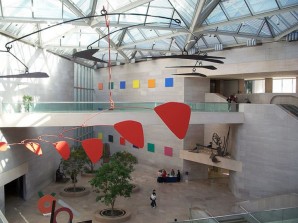
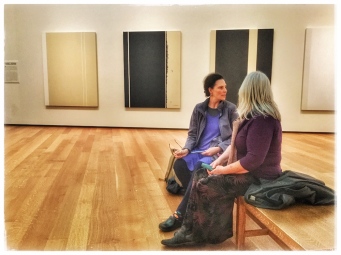

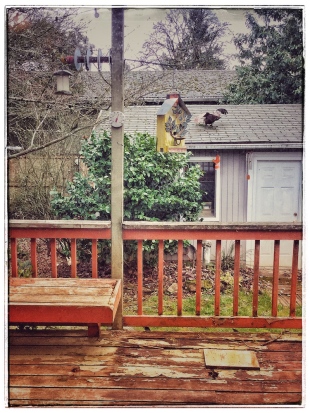 I want to offer you some radical ideas but before I do so, let me share with you where I’m at. Physically I’m looking out at the winter sun highlighting my back porch with its peeling orange railing and a little yellow birdhouse with deep green metal leaves that hangs above it. In my heart, I am finding myself weary of the in-between space I feel I occupy. It can be a lonely space and it’s one few have chosen to walk, maybe for good reason. I’m irritable today, which feels like a nagging cold I’m trying to shake. And simply, I feel I got this cold thinking about my narrative, reflecting on the thoughts of a dear Christian friend who’s taking on more of a gay activist stance in his life, and watching a promo video for an evangelical writer talking about how pastors should address the issue of homosexuality in their churches.
I want to offer you some radical ideas but before I do so, let me share with you where I’m at. Physically I’m looking out at the winter sun highlighting my back porch with its peeling orange railing and a little yellow birdhouse with deep green metal leaves that hangs above it. In my heart, I am finding myself weary of the in-between space I feel I occupy. It can be a lonely space and it’s one few have chosen to walk, maybe for good reason. I’m irritable today, which feels like a nagging cold I’m trying to shake. And simply, I feel I got this cold thinking about my narrative, reflecting on the thoughts of a dear Christian friend who’s taking on more of a gay activist stance in his life, and watching a promo video for an evangelical writer talking about how pastors should address the issue of homosexuality in their churches.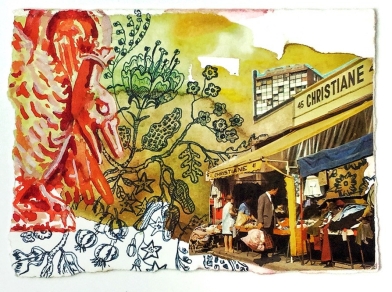

 Prince a huckster who purloined others Instagram photos and sold them as his own for $100,000 (law suits currently in process). If these are some of the folks that are being held up in the art community as wealthy laudable success stories, how on earth did we arrive here? Much may be wrong in White House, but come on, let’s do what we can to work on cleaning up our own house first. As many often hope or idealize that art is “cutting edge” and points to the future of things, perhaps we should recoil in fear realizing our President is a product of our age, in an environment many in the art world have not only endorsed but celebrated, with every note of sarcasm, bulling, self-centeredness, greed, lack of scruples, or care for others.
Prince a huckster who purloined others Instagram photos and sold them as his own for $100,000 (law suits currently in process). If these are some of the folks that are being held up in the art community as wealthy laudable success stories, how on earth did we arrive here? Much may be wrong in White House, but come on, let’s do what we can to work on cleaning up our own house first. As many often hope or idealize that art is “cutting edge” and points to the future of things, perhaps we should recoil in fear realizing our President is a product of our age, in an environment many in the art world have not only endorsed but celebrated, with every note of sarcasm, bulling, self-centeredness, greed, lack of scruples, or care for others.
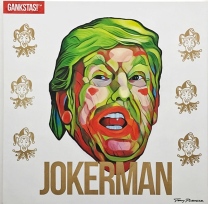

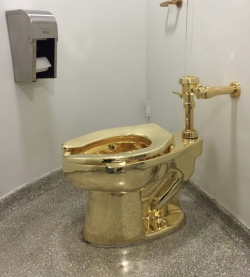
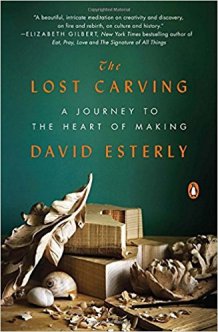 Delighting in the aisles of Given’s Books in Lynchburg Virginia I think in part I was already dazed a bit. I had found myself smitten and reassured that there are independent booksellers that are thriving. Lo-and-behold, Amazon hasn’t destroyed all outposts for those of us who like to stare at covers, thumb through pages, and smell paper. Enamored that chatting folks in the aisles seemed to have the same malady, I sauntered from used to new and perused the art books. There rich orange capitals stared back at me from a deep sea foam green cover of a paperback with carving implements and a lovely wooden acanthus leaf upon it. I opened the pages and after reading three paragraphs I found my breathing slower, more measured. I had just sipped a cup of something rich. The Lost Carving A Journey to the Heart of Making by David Easterly, was purchased at the front counter from a humorous middle aged woman with glasses and a print dress shortly thereafter.
Delighting in the aisles of Given’s Books in Lynchburg Virginia I think in part I was already dazed a bit. I had found myself smitten and reassured that there are independent booksellers that are thriving. Lo-and-behold, Amazon hasn’t destroyed all outposts for those of us who like to stare at covers, thumb through pages, and smell paper. Enamored that chatting folks in the aisles seemed to have the same malady, I sauntered from used to new and perused the art books. There rich orange capitals stared back at me from a deep sea foam green cover of a paperback with carving implements and a lovely wooden acanthus leaf upon it. I opened the pages and after reading three paragraphs I found my breathing slower, more measured. I had just sipped a cup of something rich. The Lost Carving A Journey to the Heart of Making by David Easterly, was purchased at the front counter from a humorous middle aged woman with glasses and a print dress shortly thereafter. The book chronicles Easterly’s journey recreating a wood carving of the 1600’s artist Gringling Gibbons when a tragic fire destroyed and damaged some of his work at Henry VIII’s Hampton Court Palace in England in 1986. Lady Gale living in a grace-and-favor apartment on the top floor apparently liked to live by candlelight and a bedside flame set the room, and subsequently the Christopher Wren 1689 designed interiors a light. Why that’s something we just experienced here in the Gorge in Oregon this summer with a teen playing with fireworks. Ah, the carelessness of one can certainly cost much to many.
The book chronicles Easterly’s journey recreating a wood carving of the 1600’s artist Gringling Gibbons when a tragic fire destroyed and damaged some of his work at Henry VIII’s Hampton Court Palace in England in 1986. Lady Gale living in a grace-and-favor apartment on the top floor apparently liked to live by candlelight and a bedside flame set the room, and subsequently the Christopher Wren 1689 designed interiors a light. Why that’s something we just experienced here in the Gorge in Oregon this summer with a teen playing with fireworks. Ah, the carelessness of one can certainly cost much to many.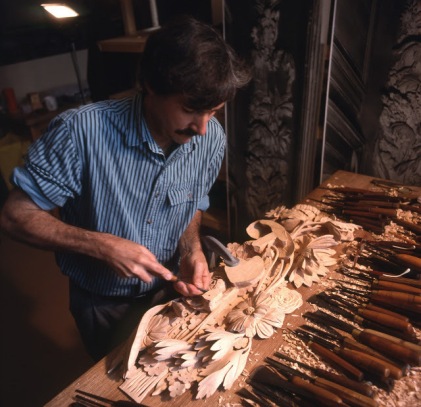
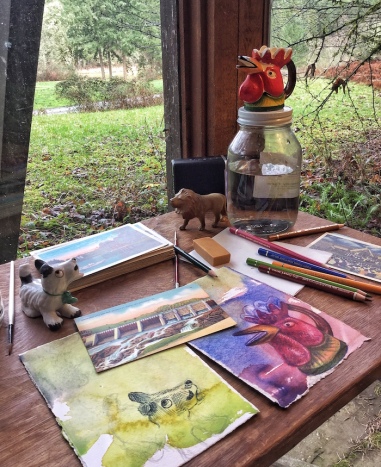

 here I have been recalibrating to new realities without pets, family and friends. The things that have been important have been simple, like eating and connecting with others and “living.” I have also been struck that I feel at least for a season here I lost my ability to create humor. The podcast
here I have been recalibrating to new realities without pets, family and friends. The things that have been important have been simple, like eating and connecting with others and “living.” I have also been struck that I feel at least for a season here I lost my ability to create humor. The podcast 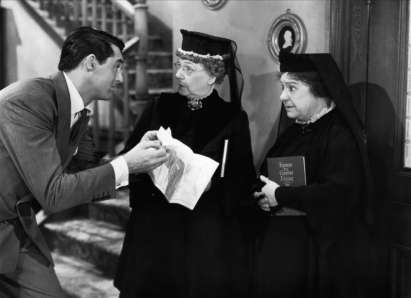
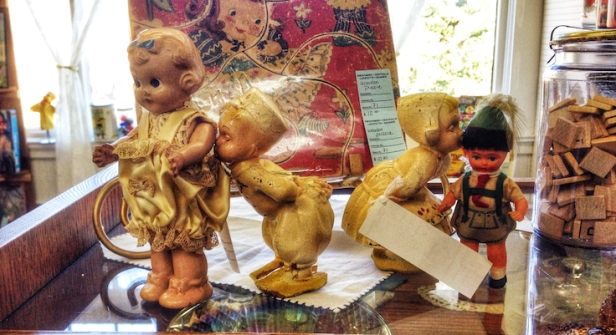
 In the midst of the record heat of our summer in Oregon I finished the amazing book, The Body Keeps the Score, Brain Mind and Body in the Healing of Trauma, by Dr. Bessel Van der Kolk. This researched, smart, and healing book filled me with awe and hope. Exhaustively thorough with data and story Dr. Van der Kolk breaks down how trauma is processed and stored, but moreover points to helpful methods of redeeming and reconciling the broken pieces of those traumatic events.
In the midst of the record heat of our summer in Oregon I finished the amazing book, The Body Keeps the Score, Brain Mind and Body in the Healing of Trauma, by Dr. Bessel Van der Kolk. This researched, smart, and healing book filled me with awe and hope. Exhaustively thorough with data and story Dr. Van der Kolk breaks down how trauma is processed and stored, but moreover points to helpful methods of redeeming and reconciling the broken pieces of those traumatic events.